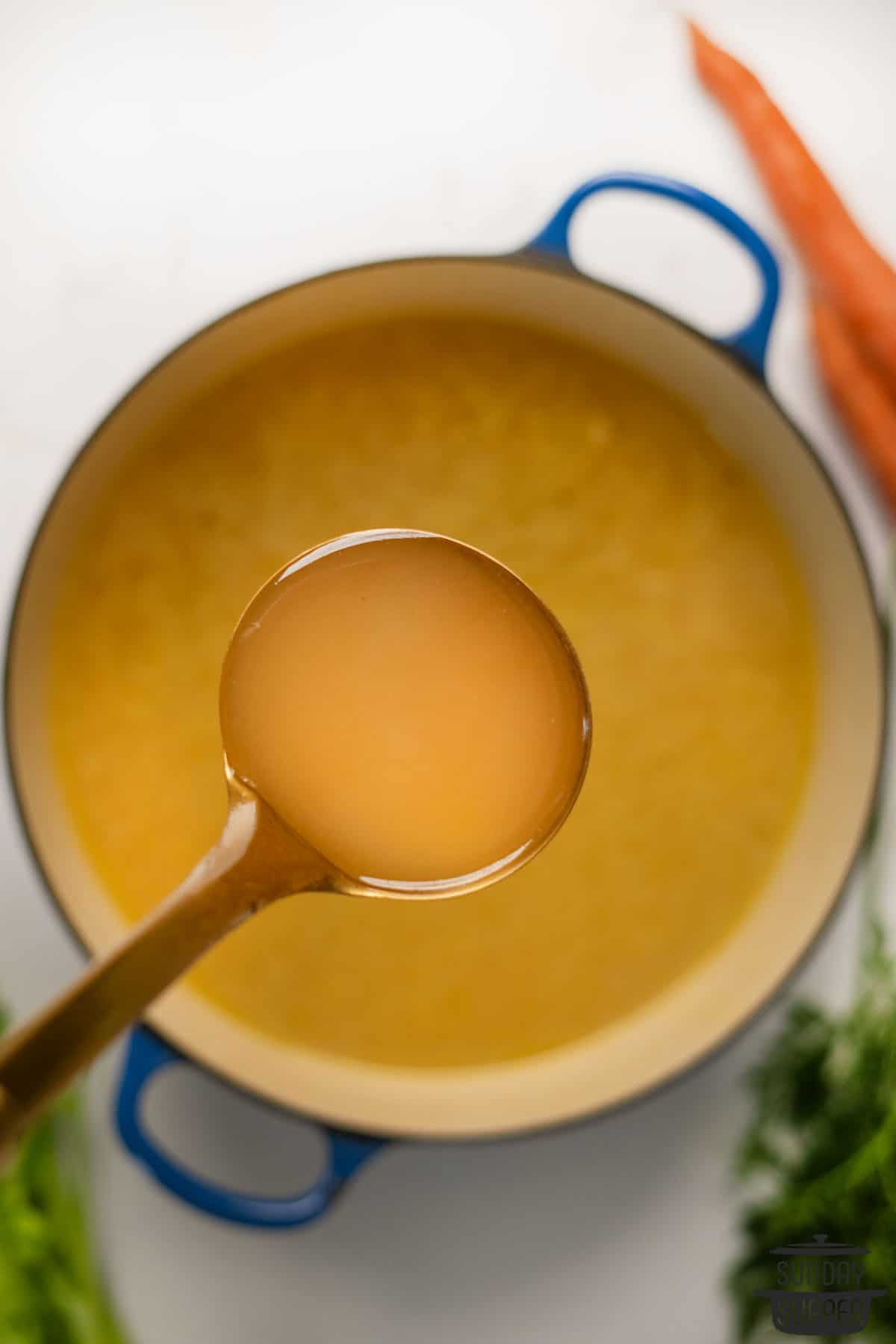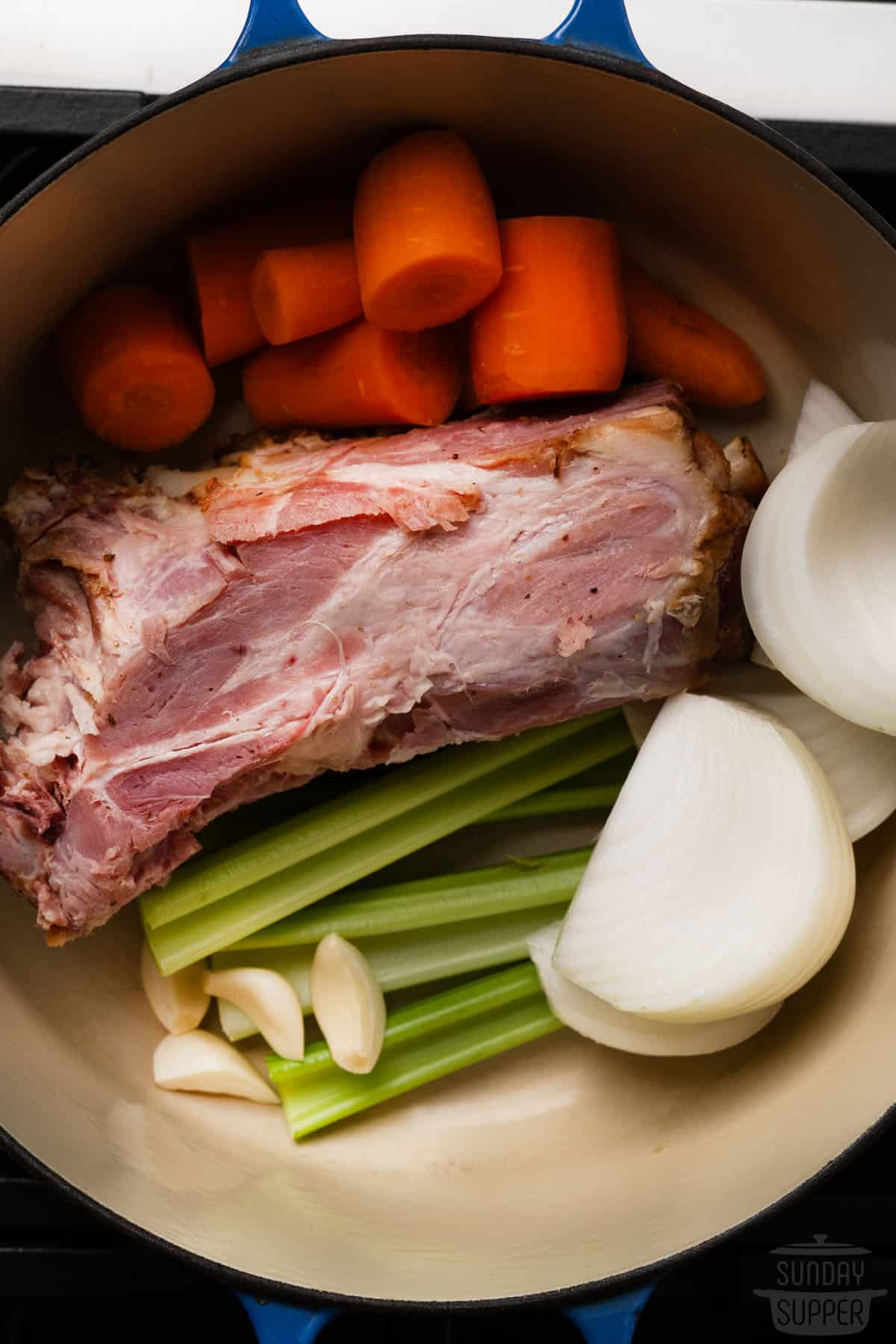Now you can make soups and gravies even better with my Ham Bone Broth recipe! You’ll never go back to store-bought stock again after tasting how much better homemade stock tastes. Plus, it’s easier than you’d ever imagine.
Up until recently, it had never occurred to me just how important using homemade stock was. Why would it matter if I used stock instead of boxed broth? I could still make tasty soups with that.
I was wrong about pork bone stock until I put a ham bone in a pot and tried it for the first time. The ham stock soup I made with it was worlds better than anything I’d ever made before. I’m not exaggerating, the difference is huge! .
Also, making ham broth at home is very simple and a great way to avoid throwing away food because you can use every part of the ham. Try it out in your next soup or gravy, and you’ll be just as amazed as I was!.
Ham bones are an excellent ingredient for making nourishing and flavorful bone broth. In this article, we’ll explore why using ham bones can take your bone broth to the next level and provide tips for getting the most out of ham bones when making bone broth.
Why Use Ham Bones for Bone Broth?
There are several reasons why ham bones make a great addition to bone broth
1. Rich in Collagen and Gelatin
Like all animal bones, ham bones contain collagen and gelatin which get released into the broth as it simmers. This gives the broth body, thickness and that glossy, mouth-coating texture associated with bone broth. Collagen and gelatin also provide important health benefits – they can improve gut health and integrity, reduce inflammation and promote skin, hair and nail growth.
2. Adds Depth of Flavor
Ham bones infuse the broth with a smoky pork-like flavor that is hard to achieve with other bones alone. The salty savory taste of the ham enhances the flavor of the finished broth.
3. Nutrient Dense
In addition to collagen, ham bones provide protein, essential fatty acids, vitamins and minerals like zinc, selenium, phosphorus, magnesium and calcium. This makes ham bone broth more nutritious than broth made with carcass bones alone.
4. Economical
Ham bones are often inexpensive or free since they are usually discarded after the ham is carved. Putting them to use in bone broth is a great way to get more value out of them.
5. Readily Available
Ham bones can easily be saved after holiday meals or purchased from butcher shops and supermarkets, so they are easy to acquire. You can stockpile ham bones in the freezer until you have enough to make a batch of broth.
Tips for Making Bone Broth with Ham Bones
Follow these tips to make the most flavorful and nutritious ham bone broth:
-
Use leftover cooked ham bones – bones that have been roasted or smoked during cooking yield more flavor. Raw ham bones can be used too but may need longer cooking times.
-
Add meaty ham bone sections – opt for bones with some leftover meat attached for extra protein and flavor. Bits of meat will fall off the bones as the broth simmers.
-
Combine ham bones with other bones – for a more balanced, mineral-rich broth, use a mix of ham bones and bones from chicken, beef, lamb or fish.
-
Include vegetables, herbs and spices – common additions are onion, carrot, celery, garlic, parsley, thyme and black peppercorns. This adds layers of flavor and nutrients.
-
Simmer for 24-48 hours – long, slow cooking times are key for extracting the most collagen, gelatin and minerals from the bones.
-
Make ahead and freeze – ham bone broth freezes beautifully for several months. Frozen broth cubes are handy for quickly making soups and stews.
Delicious Ways to Use Ham Bone Broth
Once made, ham bone broth is endlessly versatile. Here are some tasty ways to use up your homemade ham bone broth:
- Sip as a warm, soothing drink on its own
- Use as the base for soups – try ham and bean, potato bacon or vegetable
- Cook grains like rice, quinoa or barley in it
- Braise or stew meats and veggies in the broth
- Use in place of water when cooking beans, lentils or chickpeas from scratch
- Add to pan sauces, gravies and risottos for extra richness
- Turn into reductions for glazing meats or drizzling over finished dishes
- Swirl into puréed vegetables like mashed cauliflower or sweet potatoes
- Make broth-based smoothies with veggies, fruits and protein powder
So don’t throw out that ham bone after your next holiday meal – put it to use for making the most delicious and nutritious bone broth that adds value to any dish! With its concentrated nutrition and bold pork flavor, ham bone broth is too good to waste.

Broth from Ham Bone Tips
- If you have a leftover ham bone, this recipe is a great way to use it. You can freeze the bone until you’re ready to use it.
- After the stock is done, remove the bone and let it cool. Then, take out the meat that is still on the bone. It should be very tender and easily come off the bone!
- You can make this stock with just the bone and water if you need to, but adding vegetables and spices makes it taste even better. It’ll still taste great! .

Ham Bone Broth FAQs
When you don’t add salt to bone broth, it naturally has less sodium than broths and stocks that come in a jar or a box. The flavor instead comes from the bone marrow and leftover meat!.
To make ham stock, you boil ham bones, vegetables, and aromatics in water until the flavor comes out of the leftover meat and marrow. Ham stock uses bone, so it typically has a deeper flavor and thicker consistency than broth without bone.
Homemade ham stock should be used within 7 days. Frozen, stock will last 3 months. I suggest freezing it in cup-sized portions for easy defrosting for soups and gravy!.

Is Bone Broth Good For You? – Dr.Berg’s Opinion
Does ham bone broth have salt?
As salt is not necessary to add to bone broth, ham bone broth is typically a lower sodium alternative to jarred and boxed broths and stocks. The flavor instead comes from the bone marrow and leftover meat! What is ham stock made of?
Does bone broth help with a broken bone?
If one’s diet is deficient in minerals relative to bone health, then yes. However, eating a balanced dietary pattern will likely ensure adequate minerals, as well as protein, are consumed which are important for the healing process. Since bone broth contains several minerals, it may be helpful to fill nutrient gaps in one’s diet and, thus, help with healing a broken bone. However, ensuring adequate calorie, protein, and micronutrient intake is essential for supporting healing. Bone broth is low in protein and calories.
Is ham bone soup healthy?
Yes! This ham bone soup is loaded with nutrients, thanks to plenty of vegetables (like cabbage and potatoes), lean protein from the ham, and fiber-rich beans. It’s a complete meal in one pot, with about 165 calories, 3 grams of fat, 5 grams of fiber, 24 grams of carbohydrates, and 13 grams of protein per 1-cup serving.
Is bone broth good for You?
Broth made from animal bones simmered up to 20 hours can heal your gut, boost your immune system, reduce cellulite, strengthen teeth and bones, tackle inflammation and much more. Or that’s what a host of health and fitness websites claim. But there’s been little research to support those claims — until now.
